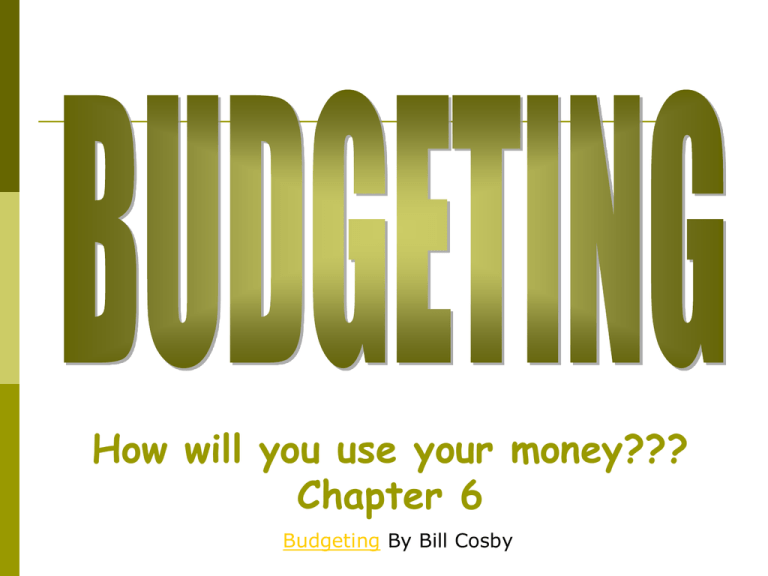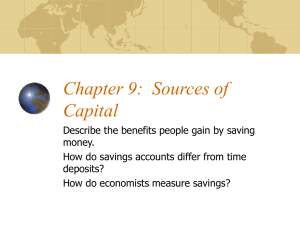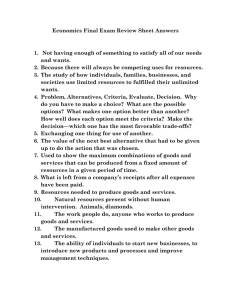Budgeting PowerPoint
advertisement

How will you use your money??? Chapter 6 Budgeting By Bill Cosby A fun strategy to get yourself in the habit of saving… …put $1/day in a piggy bank, sugar bowl or a specially marked tin for one month, then at the beginning of the following month, deposit the money in a savings account. $1 $2 $3 $5 a a a a day day day day = = = = $365 $730 $1,095 $1,825 What is a budget? A budget is a spending and savings plan based on an estimate of income and expenses. Why??? Live within your means, save towards goals, evaluate spending, financial records To analyze your financial situation, create a personal balance sheet. Assets - Liabilities = Net Worth Assets: Items of value that you own Liabilities: Debts/money you owe 6-2: Track Income and Expenses Fixed Expenses Promise to pay on certain dates and in certain amounts Examples? Rent, mortgage, property taxes, insurance Flexible Expenses Vary in amount and usually in frequency Examples? Luxury good, clothing, groceries, gas, heating bill Budget Pitfalls Not planning for predictable expenses that are not synchronized with your budget period. Not being realistic in estimating the amount of expenses. Not being specific enough in setting up budget categories. (lump under miscellaneous) Giving up Sample Family Budget 9.5% Home 44.0% Car 12.8% 9.8% 13.7% 5.2% 5.0% Clothes 13.7% 12.8% Food 9.8% Utilities 9.5% Entertainment 5.2% Savings 5.0% 44.0% Planning for Financial Security Chapter 8 8-1: Why Save? Why should you save money? Emergencies, Expensive Purchases, Recurring Expenses, Retirement, Special Goals Techniques for Building Savings Set aside money for savings FIRST, then pay your expenses. Save part (a percentage) of every paycheck. Reward yourself Payroll deductions - authorize a certain amount to taken from each of your checks and transferred to another account. Now that you are starting to save some money, where should you put it? Where should I put my money? 8-2: Savings Institutions and Accounts Commercial Banks Credit Union Savings Banks Savings Accounts Savings and Loan Associations Where should I put my money? 8-2: Savings Institutions and Accounts Commercial Banks Serve individuals and businesses Operate for a profit Offer full range of banking services Pays interest (on most accounts) Largest savings institutions in the U.S. Savings Bank Owned by it’s depositors Depositors earn dividends Offer wide range of banking services FDIC Insured (insures up to $250,000) Savings Institutions and Accounts Savings and Loan Institutions Specialize in providing funds to home buyers Offer complete line of banking services During the 1980s, many S&Ls failed and had to be closed by the government. They are now insured by the SAIF. (Saving Association Insurance Fund) Credit Unions Not for Profit Operates as a savings and lending institution for it’s members. Higher rates for deposits and low rates for loans. Insured by the NCUSIF. (National Credit Union Share Insurance Fund) Savings Institutions and Accounts Savings Accounts Accounts offered by any banking institution in which you can deposit money. Small deposit required…$50-$100 Earn interest Fees and restrictions Teller fee ATM fee Withdrawal restriction NSF Fees Where should I put my money? 8-3: Save with Safety Certificates of Deposits Money Market Accounts Interest Rate Fixed term Minimum Deposit usually $500 to $100,000 Early Withdrawal Penalties Insured Interest rate varies Bank uses the money to make short-term investments Minimum Deposit $1,000 to $2,000 Can deposit and withdrawal as needed Insured Save with Safety Bonds A bond is a promise made by a corporation or government to pay an investor a certain amount of money, plus interest, at a specified future time. Similar to an IOU. Types: Corporate Bonds Government Bonds Save with Safety - Corporate Bonds Corporate bonds Junk bonds Company makes interest payment Less risky Smaller return Businesses in trouble sell to make money High-risk, High yield Bond rating services Moody’s, Standard and Poor’s Evaluate company’s financial state and rate them AAA safest – C or D riskiest What does a savings bond look like? How much is your bond worth??? Check it out at www.ustreas.gov/kids



